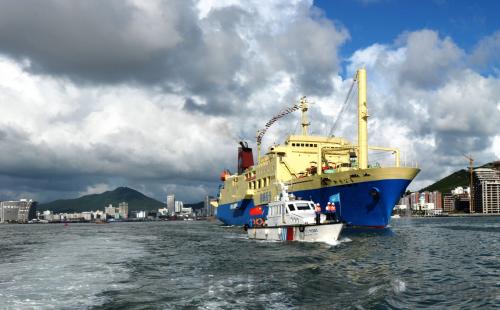|
 |
|
MAIDEN VOYAGE: The ocean liner Coconut Princess departs from a port in Sanya, southernmost Hainan Province, for the Xisha Islands in the South China Sea after a cruise route linking the two sites formally opened on September 2. Located to the southeast of Hainan, the Xisha Islands are a cluster of islets, sandbanks and reefs famous for their unusual scenery and ecosystem. The Chinese Government announced in 2009 that Hainan would be developed as a destination for international tourists, including the Xisha Islands. (ZHAO YINGQUAN) |
Martyrs' Day
On August 31, the Chinese top legislature approved the establishment of a national day to commemorate martyrs.
According to a decision by the Standing Committee of the National People's Congress (NPC), Martyrs' Day will be marked with events across the country on September 30 every year.
It is the third national memorial day in China, following Victory Day of the Chinese People's War of Resistance Against Japanese Aggression on September 3 and National Memorial Day for Nanjing Massacre Victims on December 13, both ratified by the NPC Standing Committee in February.
Martyrs, as defined by the government, are "people who sacrificed their lives for the nation's independence and prosperity, as well as the welfare of the people since the First Opium War (1840-42)."
It is believed that China has about 20 million martyrs. However, as many of them did not leave their names during wartime, only 1.93 million martyrs have been listed in the government directory. About 300 more people have been identified as martyrs annually in recent years.
The Ministry of Civil Affairs initiated feasibility studies on setting the day back in 2005, and won public support after soliciting feedback in the following years, according to ministry officials.
Maritime Adjudication
China has become a maritime judicial center for the Asia-Pacific region after three decades of effort, according to a report by the Supreme People's Court (SPC) on September 2.
Since maritime courts were first set up in China in 1984, cases have increased annually by around 10 percent. By 2013, a total of 225,283 cases had been handled, of which 215,826 had been concluded, involving over 70 countries and regions, said the SPC.
It was revealed that the annual caseload rose from a little over 100 in the early years to more than 20,000 in 2013, the most in the world.
Between 1984 and 2013, the courts detained 7,744 vessels, of which 1,660 were foreign, and auctioned off 633 of them, including 123 foreign ships.
The 10 maritime courts are located in Beihai in Guangxi Zhuang Autonomous Region, Dalian in Liaoning Province, Guangzhou in Guangdong Province, Haikou in Hainan Province, Ningbo in Zhejiang Province, Qingdao in Shandong Province, Shanghai, Tianjin, Wuhan in Hubei Province and Xiamen in Fujian Province.
IPR Courts
Special courts for intellectual property rights (IPR) cases will be established in Beijing, Shanghai and Guangzhou in Guangdong Province, as per a resolution of the Standing Committee of the National People's Congress on August 31.
The courts will focus primarily on civil and administrative lawsuits regarding patents, new plant varieties, integrated circuit layout designs and technological knowledge.
 |
|
PRESERVING TREASURED STRUCTURES: Workers repair a damaged section of the Great Wall in Luanping County, Hebei Province. The China Culture Relics Protection Foundation on September 1 established a special fund, worth 18.2 million yuan ($2.96 million), to better finance the protection of the Great Wall. The aging UNESCO World Heritage Site is confronted with pressing challenges including a shortage of renovation money in some undeveloped regions. (XINHUA) |
Rotation of Educators
Heads and teachers at prestigious schools will take turns to serve in other schools, especially in rural areas or those with poor recognition, according to a plan released on September 2.
The move is aimed at narrowing the gap between rural and urban areas and between different schools, said a statement issued by ministries of education and finance as well as human resources and social security.
It is stipulated that after serving two tenures, headmasters and deputies in primary and junior high schools will take posts in other schools in the same county or district. Teachers will also rotate among schools after a certain number of years.
In some Chinese cities, tens of thousands of students compete for access to "key senior schools" with experienced teachers and better opportunities to be admitted to universities. Schools with poor recognition or located in rural areas often find it hard to attract students.
The widening education gap between regions and schools is attributed to unbalanced economic development and investment disparity.
China aims to achieve balanced performance among schools in the same county or district by 2020.
Birth Defect Study
Chinese scientists on August 28 began a research project looking into birth defects and genetic disorders, with 900,000 babies in the country being born each year with mental or physical disabilities.
The figure makes up about 5.6 percent of all newborns, the Ministry of Technology said when announcing the research, which will cover 79 major categories of birth defects and genetic disorders and involve surveys and analysis of biological samples.
The surveys will be based on the existing screening network for birth defects.
Although China started birth defect screening 20 years ago, only 1 percent of possible defects were covered at that time, so records on a large number of birth defects and genetic disorders are lacking.
Ministry officials said that the researchers' findings will be used to create a database for further study and decision making in this area.
Trademark Report
China continues to top the world in the number of trademarks registered, according to data from the State Administration for Industry & Commerce (SAIC) on September 2.
The number of valid trademarks registered in China totaled 7.61 million at the end of June, said the administration.
The SAIC had received over 14 million trademark applications as of June. China has led the world in the number of trademark applications since 2002.
Zhang Mao, Minister of the SAIC, downplayed the surging number of trademarks, saying only a small proportion of Chinese brands are recognized in the international market. He pointed out that Chinese enterprises still rely too much upon cost advantage.
The country's revised Trademark Law went into effect in May to streamline registration procedures and improve protection.
Zhang promised more efforts to safeguard intellectual property, including trademarks, especially well-known brands, which are more vulnerable to "malicious" trademark registration.
He also pledged to increase penalties for trademark infringement, such as demanding more punitive compensation. | 